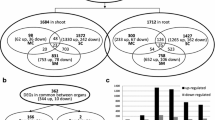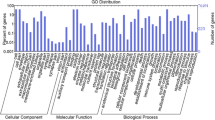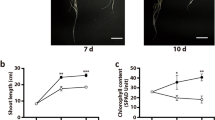Abstract
Drought stress is one of the main environmental factors that affects growth and productivity of crop plants, including lentil. To gain insights into the genome-wide transcriptional regulation in lentil root and leaf under short- and long-term drought conditions, we performed RNA-seq on a drought-sensitive lentil cultivar (Lens culinaris Medik. cv. Sultan). After establishing drought conditions, lentil samples were subjected to de novo RNA-seq-based transcriptome analysis. The 207,076 gene transcripts were successfully constructed by de novo assembly from the sequences obtained from root, leaf, and stems. Differentially expressed gene (DEG) analysis on these transcripts indicated that period of drought stress had a greater impact on the transcriptional regulation in lentil root. The numbers of DEGs were 2915 under short-term drought stress while the numbers of DEGs were increased to 18,327 under long-term drought stress condition in the root. Further, Gene Ontology analysis revealed that the following biological processes were differentially regulated in response to long-term drought stress: protein phosphorylation, embryo development seed dormancy, DNA replication, and maintenance of root meristem identity. Additionally, DEGs, which play a role in circadian rhythm and photoreception, were downregulated suggesting that drought stress has a negative effect on the internal oscillators which may have detrimental consequences on plant growth and survival. Collectively, this study provides a detailed comparative transcriptome response of drought-sensitive lentil strain under short- and long-term drought conditions in root and leaf. Our finding suggests that not only the regulation of genes in leaves is important but also genes regulated in roots are important and need to be considered for improving drought tolerance in lentil.







Similar content being viewed by others
References
Adams S, Manfield I, Stockley P, Carre IA (2015) Revised morning loops of the Arabidopsis circadian clock based on analyses of direct regulatory interactions. PLoS One 10(12):e0143943
Baker NR (2008) Chlorophyll fluorescence: a probe of photosynthesis in vivo. Annu Rev Plant Biol 59:89–113
Barbagallo RP, Oxborough K, Pallett KE, Baker NR (2003) Rapid, noninvasive screening for perturbations of metabolism and plant growth using chlorophyll fluorescence imaging. Plant Physiol 132:485–493
Battisti DS, Naylor RL (2009) Historical warnings of future food insecurity with unprecedented seasonal heat. Science 323:240–244
Bolger AM, Lohse M, Usadel B (2014) Trimmomatic: a flexible trimmer for Illumina sequence data. Bioinformatics 30:2114–2120
Cha JY, Kim J, Kim TS, Zeng Q, Wang L, Lee SY, Kim WY, Somers DE (2017) GIGANTEA is a co-chaperone which facilitates maturation of ZEITLUPE in the Arabidopsis circadian clock. Nat Commun 8(1):3
Chen J, Yu F, Liu Y, Du CQ, Li XS, Zhu SR, Wang XC, Lan WZ, Rodriguez PL, Liu XM, Li DP, Chen LB, Luan S (2016) FERONIA interacts with ABI2-type phosphatases to facilitate signaling cross-talk between abscisic acid and RALF peptide in Arabidopsis. P Natl Acad Sci USA 113:E5519–E5527
Conn SJ, Hocking B, Dayod M, Xu B, Athman A, Henderson S, Aukett L, Conn V, Shearer MK, Fuentes S, Tyerman SD, Gilliham M (2013) Protocol: optimising hydroponic growth systems for nutritional and physiological analysis of Arabidopsis thaliana and other plants. Plant Methods 9:4
Dai AG (2013) Increasing drought under global warming in observations and models. Nat Clim Chang 3:52–58
Daryanto S, Wang LX, Jacinthe PA (2016) Global synthesis of drought effects on maize and wheat production. PLoS One 11(5):e0156362
Dennis G Jr, Sherman BT, Hosack DA, Yang J, Gao W, Lane HC, Lempicki RA (2003) DAVID: database for annotation, visualization, and integrated discovery. Genome Biol 4:P3
Duan Z, Kong F, Zhang L, Li W, Zhang J, Peng L (2016) A bestrophin-like protein modulates the proton motive force across the thylakoid membrane in Arabidopsis. J Integr Plant Biol 58:848–858
Grabherr MG, Haas BJ, Yassour M, Levin JZ, Thompson DA, Amit I, Adiconis X, Fan L, Raychowdhury R, Zeng QD, Chen ZH, Mauceli E, Hacohen N, Gnirke A, Rhind N, di Palma F, Birren BW, Nusbaum C, Lindblad-Toh K, Friedman N, Regev A (2011) Full-length transcriptome assembly from RNA-Seq data without a reference genome. Nat Biotechnol 29:644–U130
Idrissi O, Udupa SM, De Keyser E, McGee RJ, Coyne CJ, Saha GC, Muehlbauer FJ, Van Damme P, De Riek J (2016) Identification of quantitative trait loci controlling root and shoot traits associated with drought tolerance in a lentil (Lens culinaris Medik.) recombinant inbred line population. Front Plant Sci 7:1174
Jiang F, Hartung W (2008) Long-distance signalling of abscisic acid (ABA): the factors regulating the intensity of the ABA signal. J Exp Bot 59:37–43
Johansen C, Baldev B, Brouwer JB, Erskine W, Jermyn WA, Lijuan L, Malik BA, Miah AA, Silim SN (1994) Biotic and abiotic stress constraining productivity of cool-season food legumes in Asia, Africa and Oceania. Curr Plant Sci Biot 19:175–194
Jones MA, Covington MF, DiTacchio L, Vollmers C, Panda S, Harmer SL (2010) Jumonji domain protein JMJD5 functions in both the plant and human circadian systems. P Natl Acad Sci USA 107:21623–21628
Kabbadj A, Makoudi B, Mouradi M, Pauly N, Frendo P, Ghoulam C (2017) Physiological and biochemical responses involved in water deficit tolerance of nitrogen-fixing Vicia faba. PLoS One 12:e0190284
Kavakli IH, Baris I, Tardu M, Gul S, Oner H, Cal S, Bulut S, Yarparvar D, Berkel C, Ustaoglu P, Aydin C (2017) The Photolyase/Cryptochrome family of proteins as DNA repair enzymes and transcriptional repressors. Photochem Photobiol 93:93–103
Kramer DM, Johnson G, Kiirats O, Edwards GE (2004) New fluorescence parameters for the determination of QA redox state and excitation energy fluxes. Photosynth Res 79:209
Ksouri N, Jimenez S, Wells CE, Contreras-Moreira B, Gogorcena Y (2016) Transcriptional responses in root and leaf of Prunus persica under drought stress using RNA sequencing. Front Plant Sci 7:1715
Kulkarni M, Soolanayakanahally R, Ogawa S, Uga Y, Selvaraj MG, Kagale S (2017) Drought response in wheat: key genes and regulatory mechanisms controlling root system architecture and transpiration efficiency. Front Chem 5:106
Lahens NF, Kavakli IH, Zhang R, Hayer K, Black MB, Dueck H, Pizarro A, Kim J, Irizarry R, Thomas RS, Grant GR, Hogenesch JB (2014) IVT-seq reveals extreme bias in RNA sequencing. Genome Biol 15:R86
Lamaoui M, Jemo M, Datla R, Bekkaoui F (2018) Heat and drought stresses in crops and approaches for their mitigation. Front Chem 6:26
Langmead B, Trapnell C, Pop M, Salzberg SL (2009) Ultrafast and memory-efficient alignment of short DNA sequences to the human genome. Genome Biol 10:R25
Lee SB, Suh MC (2013) Recent advances in cuticular wax biosynthesis and its regulation in Arabidopsis. Mol Plant 6:246–249
Legnaioli T, Cuevas J, Mas P (2009) TOC1 functions as a molecular switch connecting the circadian clock with plant responses to drought. EMBO J 28:3745–3757
Li B, Dewey CN (2011) RSEM: accurate transcript quantification from RNA-Seq data with or without a reference genome. BMC Bioinformatics 12:323
Liang C, Wang W, Wang J, Ma J, Li C, Zhou F, Zhang S, Yu Y, Zhang L, Li W, Huang X (2017) Identification of differentially expressed genes in sunflower (Helianthus annuus) leaves and roots under drought stress by RNA sequencing. Bot Stud 58:42
Liu H, Liu B, Zhao C, Pepper M, Lin C (2011) The action mechanisms of plant cryptochromes. Trends Plant Sci 16:684–691
Livak KJ, Schmittgen TD (2001) Analysis of relative gene expression data using real-time quantitative PCR and the 2(T)(-Delta Delta C) method. Methods 25:402–408
Lu H, McClung CR, Zhang C (2017) Tick tock: circadian regulation of plant innate immunity. Annu Rev Phytopathol 55:287–311
Marchler-Bauer A, Derbyshire MK, Gonzales NR, Lu S, Chitsaz F, Geer LY, Geer RC, He J, Gwadz M, Hurwitz DI, Lanczycki CJ, Lu F, Marchler GH, Song JS, Thanki N, Wang Z, Yamashita RA, Zhang D, Zheng C, Bryant SH (2015) CDD: NCBI’s conserved domain database. Nucleic Acids Res 43:D222–D226
Mengiste T, Chen X, Salmeron J, Dietrich R (2003) The BOTRYTIS SUSCEPTIBLE1 gene encodes an R2R3MYB transcription factor protein that is required for biotic and abiotic stress responses in Arabidopsis. Plant Cell 15:2551–2565
Musacchia F, Basu S, Petrosino G, Salvemini M, Sanges R (2015) Annocript: a flexible pipeline for the annotation of transcriptomes able to identify putative long noncoding RNAs. Bioinformatics 31:2199–2201
Oweis T, Hachum A, Pala M (2004) Lentil production under supplemental irrigation in a Mediterranean environment. Agr Water Manage 68:251–265
Parra G, Bradnam K, Korf I (2007) CEGMA: a pipeline to accurately annotate core genes in eukaryotic genomes. Bioinformatics 23:1061–1067
Robinson MD, McCarthy DJ, Smyth GK (2010) edgeR: a Bioconductor package for differential expression analysis of digital gene expression data. Bioinformatics 26:139–140
Sarayloo E, Tardu M, Unlu YS, Simsek S, Cevahir G, Erkey C, Kavakli IH (2017) Understanding lipid metabolism in high-lipid-producing Chlorella vulgaris mutants at the genome-wide level. Algal Res 28:244–252
Sehgal A, Sita K, Kumar J, Kumar S, Singh S, Siddique KHM, Nayyar H (2017) Effects of drought, heat and their interaction on the growth, yield and photosynthetic function of lentil (Lens culinaris Medikus) genotypes varying in heat and drought sensitivity. Front Plant Sci 8:1776
Shinozaki K, Yamaguchi-Shinozaki K (2007) Gene networks involved in drought stress response and tolerance. J Exp Bot 58:221–227
Sicher RC, Timlin D, Bailey B (2012) Responses of growth and primary metabolism of water-stressed barley roots to rehydration. J Plant Physiol 169:686–695
Singh D, Singh CK, Tomar RSS, Taunk J, Singh R, Maurya S, Chaturvedi AK, Pal M, Singh R, Dubey SK (2016) Molecular assortment of lens species with different adaptations to drought conditions using SSR markers. PLoS One 11(1):e0147213
Singh D, Singh CK, Taunk J, Tomar RS, Chaturvedi AK, Gaikwad K, Pal M (2017) Transcriptome analysis of lentil (Lens culinaris Medikus) in response to seedling drought stress. BMC Genomics 18:206
Stoddard FL, Balko C, Erskine W, Khan HR, Link W, Sarker A (2006) Screening techniques and sources of resistance to abiotic stresses in cool-season food legumes. Euphytica 147:167–186
Sudheesh S, Verma P, Forster JW, Cogan NO, Kaur S (2016) Generation and characterisation of a reference transcriptome for lentil (Lens culinaris Medik.). Int J Mol Sci 17(11). https://doi.org/10.3390/ijms17111887
Tardu M, Dikbas UM, Baris I, Kavakli IH (2016) RNA-seq analysis of the transcriptional response to blue and red light in the extremophilic red alga, Cyanidioschyzon merolae. Funct Integr Genomic 16:657–669
Tardu M, Bulut S, Kavakli IH (2017) MerR and ChrR mediate blue light induced photo-oxidative stress response at the transcriptional level in Vibrio cholerae. Sci Rep 7:40817
Wang W, Vinocur B, Altman A (2003) Plant responses to drought, salinity and extreme temperatures: towards genetic engineering for stress tolerance. Planta 218:1–14
Xie Y, Wu G, Tang J, Luo R, Patterson J, Liu S, Huang W, He G, Gu S, Li S, Zhou X, Lam TW, Li Y, Xu X, Wong GK, Wang J (2014) SOAPdenovo-trans: de novo transcriptome assembly with short RNA-Seq reads. Bioinformatics 30:1660–1666
Yao JN, Sun DW, Cen HY, Xu HX, Weng HY, Yuan F, He Y (2018) Phenotyping of Arabidopsis drought stress response using kinetic chlorophyll fluorescence and multicolor fluorescence imaging. Front Plant Sci 9:603
Zhao QY, Wang Y, Kong YM, Luo D, Li X, Hao P (2011) Optimizing de novo transcriptome assembly from short-read RNA-Seq data: a comparative study. BMC Bioinformatics 12(Suppl 14):S2
Acknowledgements
We would like to thank the Southeastern Anatolia Agricultural Research Institute providing us the seed of Lens culinaris Medik. cv. Sultan.
Funding
This work was supported by an Istanbul Development Agency grant (ISTKA-TR/14/EVK/0039) to IHK, and by an Istanbul University BAP project (21207, 22583) to GC and IHK.
Author information
Authors and Affiliations
Contributions
HM and MT carried out the experiments. MT performed the analysis. MT, HM, and GC contributed in writing the manuscript. IHK designed the experiments and wrote the manuscript.
Corresponding author
Additional information
Publisher’s note
Springer Nature remains neutral with regard to jurisdictional claims in published maps and institutional affiliations.
Electronic supplementary material
Figure S1
(PDF 226 kb)
Figure S2
(PNG 289 kb)
Table S1
(XLSX 10 kb)
Table S2
(XLSX 9 kb)
Table S3
Gene annotation from Swiss-Port (XLS 15017 kb)
Table S4
Gene annotation from UniRef (XLS 15453 kb)
Table S5
(XLSX 73 kb)
Table S6
(XLSX 502 kb)
Table S7
Identified DEGs in all samples (XLSX 2623 kb)
Table S8
(XLSX 13 kb)
Table S9
(XLSX 37 kb)
Rights and permissions
About this article
Cite this article
Morgil, H., Tardu, M., Cevahir, G. et al. Comparative RNA-seq analysis of the drought-sensitive lentil (Lens culinaris) root and leaf under short- and long-term water deficits. Funct Integr Genomics 19, 715–727 (2019). https://doi.org/10.1007/s10142-019-00675-2
Received:
Revised:
Accepted:
Published:
Issue Date:
DOI: https://doi.org/10.1007/s10142-019-00675-2




